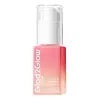What's inside
What's inside
 Key Ingredients
Key Ingredients

 Benefits
Benefits

 Concerns
Concerns

 Ingredients Side-by-side
Ingredients Side-by-side

Water
Skin ConditioningPropylene Glycol
HumectantGlycerin
HumectantTrehalose
Humectant1,2-Hexanediol
Skin ConditioningHydroxyacetophenone
AntioxidantEryngium Maritimum Callus Culture Filtrate
Skin ConditioningRetinyl Palmitate
Skin ConditioningSodium Hyaluronate
HumectantXanthan Gum
EmulsifyingPEG-40 Hydrogenated Castor Oil
EmulsifyingHydroxyethylcellulose
Emulsion StabilisingDisodium EDTA
Carnosine
Skin ConditioningParfum
MaskingTocopherol
AntioxidantEthylhexylglycerin
Skin ConditioningCI 19140
Cosmetic ColorantAcetyl Hexapeptide-8
HumectantWater, Propylene Glycol, Glycerin, Trehalose, 1,2-Hexanediol, Hydroxyacetophenone, Eryngium Maritimum Callus Culture Filtrate, Retinyl Palmitate, Sodium Hyaluronate, Xanthan Gum, PEG-40 Hydrogenated Castor Oil, Hydroxyethylcellulose, Disodium EDTA, Carnosine, Parfum, Tocopherol, Ethylhexylglycerin, CI 19140, Acetyl Hexapeptide-8
Water
Skin ConditioningButylene Glycol
HumectantPropylene Glycol
HumectantCaprylic/Capric Glycerides Polyglyceryl-10 Esters
EmollientBetaine
HumectantPrunus Persica Fruit Extract
AbrasiveSqualane
EmollientMadecassoside
AntioxidantRetinol
Skin ConditioningHydroxyacetophenone
Antioxidant1,2-Hexanediol
Skin ConditioningCetearyl Olivate
Pentylene Glycol
Skin ConditioningSorbitan Olivate
EmulsifyingAcrylates/C10-30 Alkyl Acrylate Crosspolymer
Emulsion StabilisingAllantoin
Skin ConditioningO-Cymen-5-Ol
AntimicrobialXanthan Gum
EmulsifyingAminomethyl Propanol
BufferingRetinyl Propionate
Skin ConditioningHydroxypinacolone Retinoate
Skin ConditioningHydroxyphenyl Propamidobenzoic Acid
Skin ConditioningAroma
Quaternium-73
Glycerin
HumectantCaprylic/Capric Triglyceride
MaskingPolysorbate 80
EmulsifyingPolysorbate 20
EmulsifyingPhenoxyethanol
PreservativeEthylhexylglycerin
Skin ConditioningWater, Butylene Glycol, Propylene Glycol, Caprylic/Capric Glycerides Polyglyceryl-10 Esters, Betaine, Prunus Persica Fruit Extract, Squalane, Madecassoside, Retinol, Hydroxyacetophenone, 1,2-Hexanediol, Cetearyl Olivate, Pentylene Glycol, Sorbitan Olivate, Acrylates/C10-30 Alkyl Acrylate Crosspolymer, Allantoin, O-Cymen-5-Ol, Xanthan Gum, Aminomethyl Propanol, Retinyl Propionate, Hydroxypinacolone Retinoate, Hydroxyphenyl Propamidobenzoic Acid, Aroma, Quaternium-73, Glycerin, Caprylic/Capric Triglyceride, Polysorbate 80, Polysorbate 20, Phenoxyethanol, Ethylhexylglycerin
Ingredients Explained
These ingredients are found in both products.
Ingredients higher up in an ingredient list are typically present in a larger amount.
1,2-Hexanediol is a synthetic liquid and another multi-functional powerhouse.
It is a:
- Humectant, drawing moisture into the skin
- Emollient, helping to soften skin
- Solvent, dispersing and stabilizing formulas
- Preservative booster, enhancing the antimicrobial activity of other preservatives
Ethylhexylglycerin (we can't pronounce this either) is commonly used as a preservative and skin softener. It is derived from glyceryl.
You might see Ethylhexylglycerin often paired with other preservatives such as phenoxyethanol. Ethylhexylglycerin has been found to increase the effectiveness of these other preservatives.
Glycerin is already naturally found in your skin. It helps moisturize and protect your skin.
A study from 2016 found glycerin to be more effective as a humectant than AHAs and hyaluronic acid.
As a humectant, it helps the skin stay hydrated by pulling moisture to your skin. The low molecular weight of glycerin allows it to pull moisture into the deeper layers of your skin.
Hydrated skin improves your skin barrier; Your skin barrier helps protect against irritants and bacteria.
Glycerin has also been found to have antimicrobial and antiviral properties. Due to these properties, glycerin is often used in wound and burn treatments.
In cosmetics, glycerin is usually derived from plants such as soybean or palm. However, it can also be sourced from animals, such as tallow or animal fat.
This ingredient is organic, colorless, odorless, and non-toxic.
Glycerin is the name for this ingredient in American English. British English uses Glycerol/Glycerine.
Learn more about GlycerinHydroxyacetophenone is antioxidant with skin conditioning and soothing properties. It also boosts the efficiency of preservatives.
This ingredient is not irritating or sensitizing.
Propylene Glycol is an odorless, colorless liquid. As a humectant, it helps skin retain moisture. It also aids in delivering active ingredients.
Another role of this ingredient is preventing a product from melting or freezing. Propylene glycol also adds antimicrobrial properties to a product, elongating product lifespan.
This ingredient is considered an organic alcohol and commonly added into both cosmetics and foods.
Those with sensitive skin or conditions may develop a rash when using this ingredient.
Learn more about Propylene GlycolWater. It's the most common cosmetic ingredient of all. You'll usually see it at the top of ingredient lists, meaning that it makes up the largest part of the product.
So why is it so popular? Water most often acts as a solvent - this means that it helps dissolve other ingredients into the formulation.
You'll also recognize water as that liquid we all need to stay alive. If you see this, drink a glass of water. Stay hydrated!
Learn more about WaterXanthan gum is used as a stabilizer and thickener within cosmetic products. It helps give products a sticky, thick feeling - preventing them from being too runny.
On the technical side of things, xanthan gum is a polysaccharide - a combination consisting of multiple sugar molecules bonded together.
Xanthan gum is a pretty common and great ingredient. It is a natural, non-toxic, non-irritating ingredient that is also commonly used in food products.
Learn more about Xanthan Gum